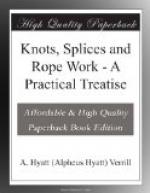[Illustration: FIG. 46.—Chain hitch.]
[Illustration: FIG. 47.—Chain hitch with bar.]
[Illustration: FIG. 48.—Rolling hitch.]
[Illustration: FIG. 49.—Magnus hitch.]
[Illustration: FIG. 50.—Studding-sail bend.]
[Illustration: FIG. 51 A.—Roband hitch (front).]
[Illustration: FIG. 51 B.—Roband hitch (back).]
[Illustration: FIG. 52.—Midshipman’s hitch.]
[Illustration: FIG. 53.—Fisherman’s hitch.]
[Illustration: FIG. 54.—Gaff-topsail halyard bend.]
CHAPTER IV
NOOSES, LOOPS AND MOORING KNOTS
Nothing is more interesting to a landsman than the manner in which a sailor handles huge, dripping hawsers or cables and with a few deft turns makes then fast to a pier-head or spile, in such a way that the ship’s winches, warping the huge structure to or from the dock, do not cause the slightest give or slip to the rope and yet, a moment later, with a few quick motions, the line is cast off, tightened up anew, or paid out as required. Clove hitches, used as illustrated in Fig. 55, and known as the “Waterman’s Knot,” are often used, with a man holding the free end, for in this way a slight pull holds the knot fast, while a little slack gives the knot a chance to slip without giving way entirely and without exerting any appreciable pull on the man holding the end.
[Illustration: FIG. 55.—Waterman’s knot.]
“Larks’ Heads” are also used in conjunction with a running noose, as shown in Fig. 56, while a few turns under and over and around a cleat, or about two spiles, is a method easily understood and universally used by sailors (Fig. 57). The sailor’s knot par excellence, however, is the “Bow-line” (Fig. 58), and wherever we find sailors, or seamen, we will find this knot in one or another of its various forms. When you can readily and surely tie this knot every time, you may feel yourself on the road to “Marline-spike Seamanship,” for it is a true sailor’s knot and never slips, jams, or fails; is easily and quickly untied, and is useful in a hundred places around boats or in fact in any walk of life. The knot in its various stages is well shown in Fig. 59 and by following these illustrations you will understand it much better than by a description alone. In A the rope is shown with a bight or cuckold’s neck formed with the end over the standing part. Pass A back through the bight, under, then over, then under, as shown in B, then over and down through the bight, as shown in C and D, and draw taut, as in E. The “Bow-line on a Bight” (Fig 60) is just as easily made and is very useful in slinging casks or barrels and in forming a seat for men to be lowered over cliffs, or buildings, or to be hoisted aloft aboard ship for painting, cleaning, or rigging. A “Running Bow-line” (Fig. 61) is merely




